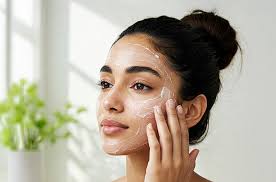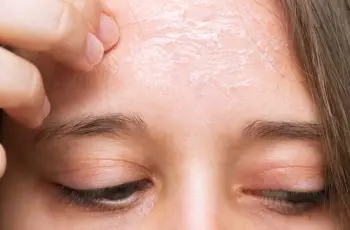
Chemical exfoliation has become an essential part of modern skincare routines, offering a gentler and more effective alternative to harsh scrubs and manual exfoliators that may damage or irritate sensitive skin types.
This process uses specific active ingredients, like acids and enzymes, to dissolve the bonds between dead skin cells and lift them away, revealing smoother, fresher, and more radiant-looking skin underneath.
Unlike physical exfoliants that rely on abrasive grains or tools, chemical exfoliants provide even exfoliation without the risk of causing microtears or over-scrubbing, which can lead to inflammation.
By working at the cellular level, chemical exfoliants not only improve texture and clarity but also tackle concerns like acne, fine lines, hyperpigmentation, and clogged pores effectively and efficiently.
Chemical exfoliation involves using Alpha Hydroxy Acids (AHAs) and Beta Hydroxy Acids (BHAs) to gently slough off dead skin cells and decongest pores without causing visible peeling or discomfort.
AHAs are water-soluble acids that work on the surface layer of the skin to improve smoothness and brightness, making them excellent for targeting dullness and sun damage.
Common AHAs include glycolic acid from sugar cane, lactic acid from milk, and malic acid from apples—all of which support skin renewal while promoting hydration and luminosity.
BHAs, such as salicylic acid, are oil-soluble and penetrate deep into the pores, making them ideal for oily or acne-prone skin types that struggle with congestion and blackheads.
Salicylic acid not only dissolves oil and debris trapped inside pores but also has anti-inflammatory benefits that help reduce redness and calm breakouts.
The acids used in chemical exfoliants break down the glue-like substance that holds dead skin cells together, allowing these dull, non-functional cells to shed naturally and safely.
This results in improved skin tone and texture, increased cell turnover, and a more youthful glow that builds over time with consistent use of the right products.
For best results, it’s important to understand the different types of chemical exfoliants and how to choose the ones that suit your skin type and concerns most effectively.
Glycolic acid, the smallest and most potent AHA, is highly effective at exfoliating the skin’s surface and is best suited for normal to oily skin types dealing with fine lines or hyperpigmentation.
Lactic acid offers a gentler alternative for those with sensitive or dry skin, as it not only exfoliates but also hydrates the skin, improving moisture retention and minimizing irritation.
Malic acid is another gentle AHA that enhances overall radiance and can be used by those new to chemical exfoliation or those with very delicate skin barriers.
Salicylic acid, a key BHA, is ideal for those with oily or acne-prone skin as it clears out impurities from deep within the pores and helps control future breakouts and excess oil production.
To safely incorporate chemical exfoliants into your skincare routine, it’s essential to start slowly and observe how your skin responds to active ingredients, especially if you’re new to exfoliating acids.
Begin by using chemical exfoliants just two to three times a week and increase frequency only if your skin tolerates it well and shows no signs of irritation or sensitivity.
Chemical exfoliants come in several formats, including cleansers, toners, serums, and masks, each offering different strengths and levels of penetration depending on your skincare goals.
Cleansers typically have low concentrations of acids and can be used daily, while toners and serums usually deliver higher potency and should be applied less frequently.
Face masks infused with exfoliating acids can be powerful weekly treatments to target dullness or congestion, but they should be limited to avoid over-exfoliating and compromising your skin barrier.
Always follow chemical exfoliation with a hydrating moisturizer and broad-spectrum sunscreen, as newly exfoliated skin is more vulnerable to UV damage and environmental stressors.
Sunscreen with SPF 30 or higher is essential to prevent sunburn and to protect the results of your exfoliation efforts from being undone by UV exposure.
Hydrating masks or serums can be used after exfoliation to soothe the skin and lock in moisture, helping to maintain balance and comfort following the treatment.
Avoid layering chemical exfoliants with other strong actives like retinoids or vitamin C right after exfoliating to minimize the risk of irritation, redness, or skin barrier damage.
If you wish to use a face mask after exfoliation, opt for calming, hydrating, or replenishing masks rather than those that contain acids, clay, or drying ingredients.
It’s best to wait about 20 to 30 minutes after applying a chemical exfoliant before applying other skincare products to give your skin time to adjust and absorb the active ingredients.
Take extra care around the delicate eye area, as the skin here is thinner and more prone to irritation—avoid using strong acids close to this region unless specified as eye-safe.
Some eye creams may contain very low concentrations of mild exfoliants or hydrating acids like lactic acid, but these should be used with caution and only if your skin tolerates them well.
The timeline for seeing results from chemical exfoliation can vary, but many users notice smoother, brighter skin within one to two weeks of consistent, proper use of exfoliating products.
More significant changes, such as reduced hyperpigmentation, minimized fine lines, and clearer pores, often become apparent after four to eight weeks of regular application.
If you’re addressing deeper concerns like acne scars or sun damage, it may take several months of consistent exfoliation and sun protection to see optimal improvements.
While chemical exfoliation is highly effective, overuse can backfire and lead to redness, flaking, or sensitization, so moderation and consistency are key to long-term success.
Those with oily or acne-prone skin may benefit the most from BHAs, which work deep inside the pores to reduce oiliness, unclog blackheads, and prevent future breakouts.
Even oily skin needs moisture, so pairing BHAs with oil-free moisturizers containing humectants like hyaluronic acid can help keep the skin balanced and hydrated without adding shine.
Understanding what causes oily skin—such as genetics, hormones, diet, or stress—can help you choose the right exfoliation and skincare products to manage it more effectively.
Gentle cleansing with salicylic acid, using alcohol-free toners, and applying mattifying products can help reduce midday shine and control sebum production without drying out your skin.
Despite having excess oil, oily skin types can still benefit from non-comedogenic face oils like tea tree oil or rosehip oil that help regulate oil production and soothe inflammation.
Hydration remains critical in any exfoliation routine, as skin that is overly dry can respond by producing more oil, leading to even more breakouts and congestion.
Blotting papers, oil-control primers, and lightweight gel moisturizers are helpful tools for managing oily skin throughout the day, especially in hot or humid climates.
Chemical exfoliation, when used appropriately and regularly, can transform your skin’s texture, reduce imperfections, and restore clarity, making it a powerful tool in any skincare arsenal.
By understanding your skin’s needs and choosing the right acids and frequencies, you can safely exfoliate and enjoy long-lasting results without damaging your skin barrier.
With patience, consistency, and protective skincare habits, you can reveal smoother, healthier, and more radiant skin that glows from within and is less prone to acne, dullness, or rough texture.
Chemical exfoliation is not just a trend but a science-backed method to enhance your skincare results and build a stronger, clearer complexion over time with the right strategy and support.


